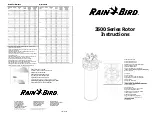
Performing Time Domain Measurements
Practical Considerations
Chapter 4
95
2. Filtering
When a measurement is made in the frequency domain, it is inherently band-limited because
it is only measured up to a certain frequency. Therefore, in calculating the time-domain
response, this is equivalent to measuring a device with a sharp frequency cutoff. For example,
consider an ideal, lossless transmission line capable of passing an infinite bandwidth. The
impulse response of this device would be an impulse function.
However, if we measured this ideal transmission line to only 10 GHz, it would be like
measuring an ideal 10 GHz low-pass filter. When the resulting rectangular frequency domain
response is transformed to the time domain, it has a sin(x)/x response. Compared to the case
of the infinite frequency range, the width of the impulse response has become broader, and the
level of the side lobes has increased, limiting the effective system dynamic range.
The width of the impulse response is directly related to the measurement frequency range.
The level of the side lobes depends primarily on the bandwidth of the measurement; but can
be greatly improved by filtering of the frequency domain response. This is accomplished at the
expense of a further degradation in the width of the impulse response (or step response rise
time).
The multiport test system uses a default filter value of 0.375, and provides equivalent rise
times of T=0.7/F (where T is the effective step rise time or impulse width in picoseconds, and F
is the frequency span in gigahertz). For example, a 20 GHz measurement on the N4418A
provides an equivalent time of 36 pS and a dynamic range of 110 dB.
Summary of Contents for N4413A
Page 4: ...iv ...
Page 11: ...1 1 About the Multiport Test System ...
Page 18: ...About the Multiport Test System Available Options and Accessories Chapter 1 8 ...
Page 19: ...9 2 User Interface ...
Page 27: ...17 3 Using the Multiport Test System ...
Page 89: ...79 4 Performing Time Domain Measurements ...
Page 109: ...99 5 Menu Reference ...
Page 163: ...153 6 Maintenance and Troubleshooting ...
Page 172: ...Maintenance and Troubleshooting Contacting Agilent Chapter 6 162 ...
Page 173: ...163 7 Instrument Information ...
Page 208: ...Instrument Information Specifications and Characteristics Chapter 7 198 ...
Page 209: ...199 8 Safety and Regulatory Information ...
Page 218: ...Safety and Regulatory Information Regulatory Information Chapter 8 208 ...
Page 219: ...209 A Other Technical Procedures ...
Page 224: ...Other Technical Procedures IF Gain Adjustment Appendix A 214 ...
















































